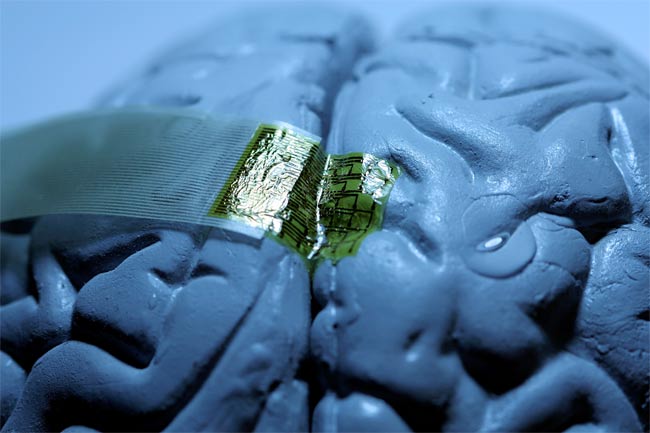New Implants Mold to Brain Like Shrink-Wrap

New silken brain implants that mold to the organ's grooves and crevices like shrink-wrap could lead to better devices for monitoring and controlling seizures.
"They can also serve as advanced brain-machine interfaces for control of prosthetics and other devices," said John Rogers, a professor of materials science and engineering at the University of Illinois, Urbana-Champaign.
The new implants could transmit signals from the brain to the prosthetic, Rogers and his colleagues explain in the April 18 issue of the journal Nature Materials.
Options for brain electrodes
Currently, doctors measure brain activity in one of two ways: tiny, needle-like electrodes that can penetrate deep into brain tissue; or so-called micro-electrode arrays that consist of dozens of semi-flexible wire electrodes, usually fixed to rigid silicon grids that do not conform to the brain's shape.
While the tiny pins have good spatial resolution, they can damage brain tissue. The microarrays do no damage but only give coarse resolution for brain measurements.
"We think that our system provides advantages over these two alternatives," Rogers said. The new implants aren't sharp; they mold to the brain so could remain stable even when the brain moves in the skull as it sometimes does, and since they spread across the brain they could capture activity of larger networks of brain cells.
Sign up for the Live Science daily newsletter now
Get the world’s most fascinating discoveries delivered straight to your inbox.
Silken brain implants
The team printed tiny strips of metal electrodes each just five times the thickness of a human hair onto a thin plastic mesh.
"The entire thing rests on a sheet of silk that provides a 'handle' for manipulating the device as it is mounted on the brain," Rogers told LiveScience. The silk came from cocoons of the caterpillar Bombyx mori.
Once placed on the brain, a small amount of salt solution is used to dissolve the silk.
"As the silk dissolves, the metal electrode mesh gently wraps the curved surfaces and folds of the brain, to establish intimate contact for the purpose of recording electrical activity," Rogers said.
Cat brains
They tested three variations of the electrodes, one of which didn't use the silk foundation, on anesthetized adult cats. The cats were shown images while the flexible electrodes recorded activity from the brain's visual cortex. Results showed the most robust signals came from the thinnest mesh-silk combination.
In addition, the cats' brains showed no inflammation for at least four weeks.
Though the device is currently powered remotely, Rogers and his colleagues are working on ultrathin batteries and electronics to make the entire system self-contained.
Jeanna Bryner is managing editor of Scientific American. Previously she was editor in chief of Live Science and, prior to that, an editor at Scholastic's Science World magazine. Bryner has an English degree from Salisbury University, a master's degree in biogeochemistry and environmental sciences from the University of Maryland and a graduate science journalism degree from New York University. She has worked as a biologist in Florida, where she monitored wetlands and did field surveys for endangered species, including the gorgeous Florida Scrub Jay. She also received an ocean sciences journalism fellowship from the Woods Hole Oceanographic Institution. She is a firm believer that science is for everyone and that just about everything can be viewed through the lens of science.









